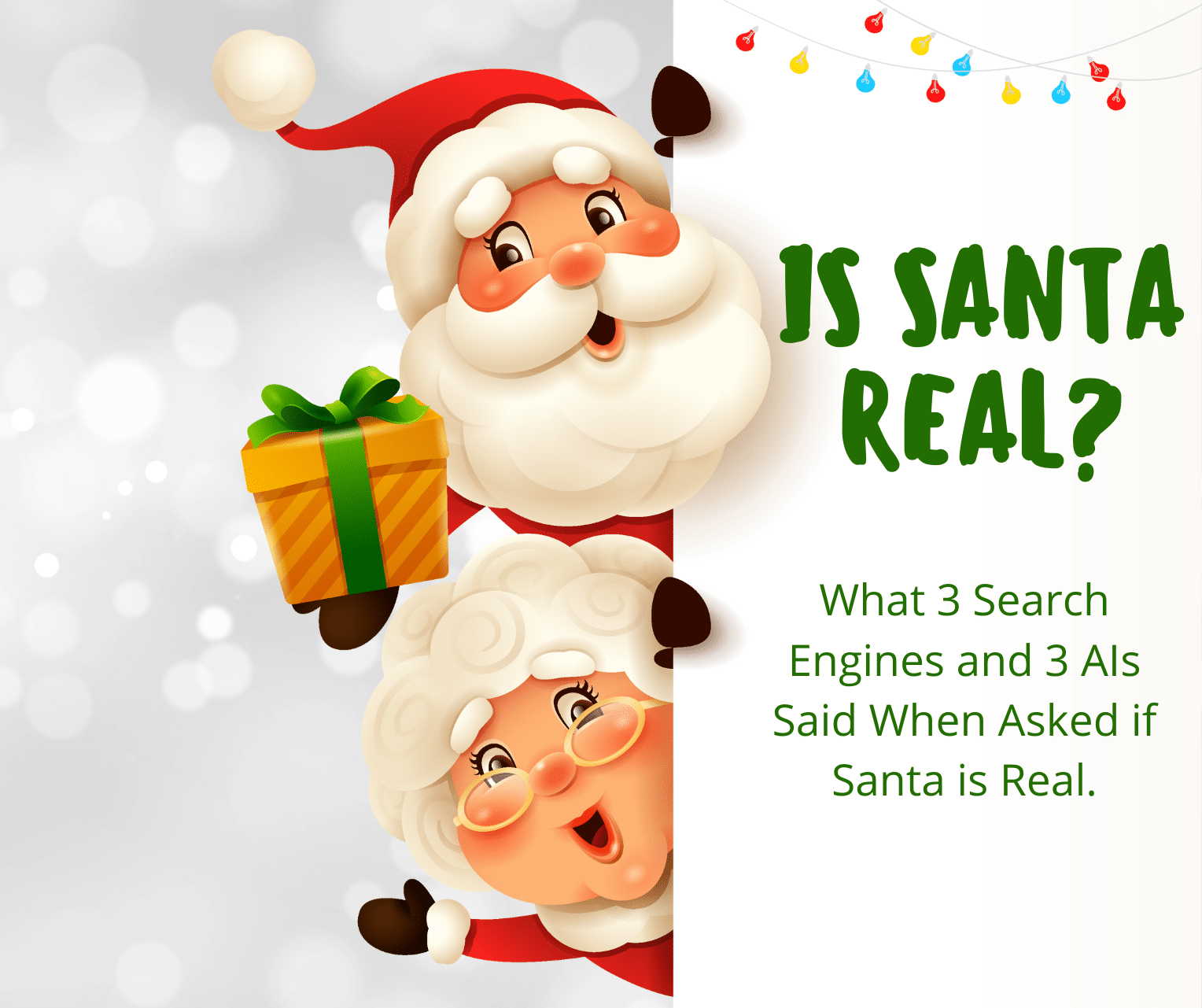
Is Santa Real? That’s a good question. The short answer is that it depends on who you ask. That’s what I found out when I asked three different search engines and 3 different AIs. I asked ChatGPT, Google Bard, and Claude AI. Then, I asked three different search engines whether or not Santa is real, I asked Google, Bing, and Duck Duck Go.There is an article published at the New York Post, Angry parents urge Google to change answer to question: ‘Is Santa real?’ . I have to agree, as a parent myself, I’m not very amused about the answers that the search engines, especially Google are giving. However, angry or not, parents need to understand that search engines do not manually change the search engine results pages. The search engine results are, for the most part, not manipulated by Google. For the most part, Google’s search engine algorithm, the way they determine which web pages show up at the top of the search engine results pages, is “fair”.
Everyweb page and every website has an equal chance of showing up at the top of the search engine results–and it mostly comes down to the content on those web pages. There are, however, around 1300 possible search engine ranking factors, so it’s generally not as “easy” as that. But my honest opinion on this, as a search marketing professional having practiced SEO for over 20 years, is that Google shouldn’t step in and manipulate the search engine results “manually”, just for one particular search query because someone doesn’t like what appears in the search engine results pages. If you don’t like the search engine results and what appears there, YOU have the opportunity to change the search results. Just create better, more relevant content that is better than what currently appears there. That said, let’s take a look at what 3 different search engines and 3 different AIs have to say about whether or not “Santa Is Real”.
Jump To
ToggleIs Santa Real?
The NY Post article focuses primarily on 1 search engine, Google, and shows that there’s one main search engine result, the top search engine result, that parents don’t like. Google’s search engine results for “Is Santa Real?” is below:
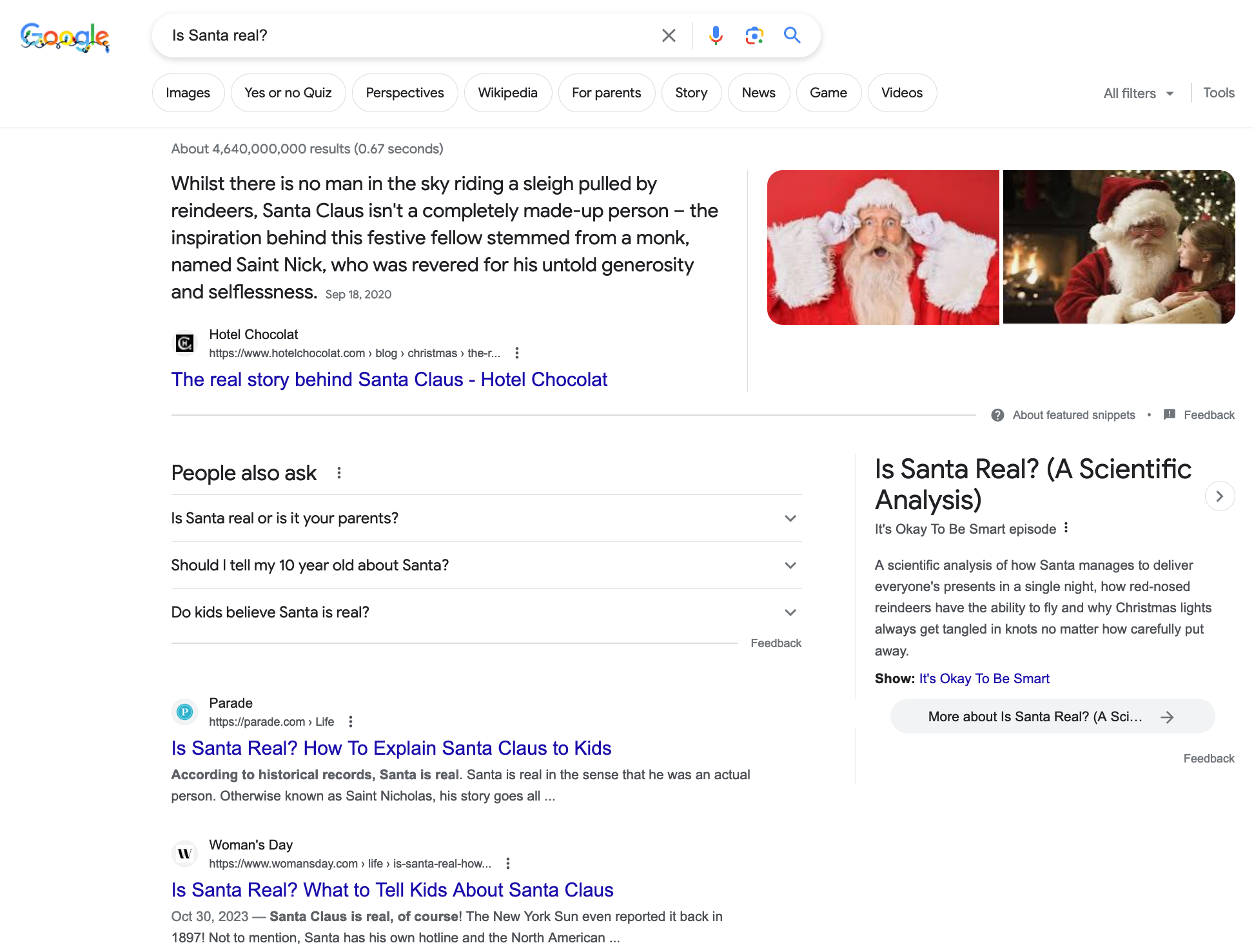
As you can see, there is one top “main” result, this is called the “featured snippet” result for the search query. Not all search queries cause a featured snippet to appear. But for a lot of the searches, it does appear. In this case, Google’s algorithm has decided that this particular web page, from hotelchocolat.com, is good enough to be “better” than other articles or web pages addressing the search query. This result also brings up the “People Also Ask” questions, where other web pages have answered those questions. Google’s decided that those questions are related and appropriate to the original search query, “Is Santa Real?”.
While the search results for this search query does have a scientific answer as well as information about the history of Santa Claus, I don’t think that the history, while partly relevant, should be highlighted here. I’m not a big fan of the featured snippet for this search query, as it does appear to say that Santa, as we know him (and as kids know him in present-day), is not real. I can see how this would definitely concern many parents. But it’s truly not Google’s fault–it’s more the fault of who wrote the article that appears as the featured snippet here.
Let’s take a look at some other search engine results, and then look at how popular AIs answer this question, Is Santa Real?
Here is what ChatGPT has to say:
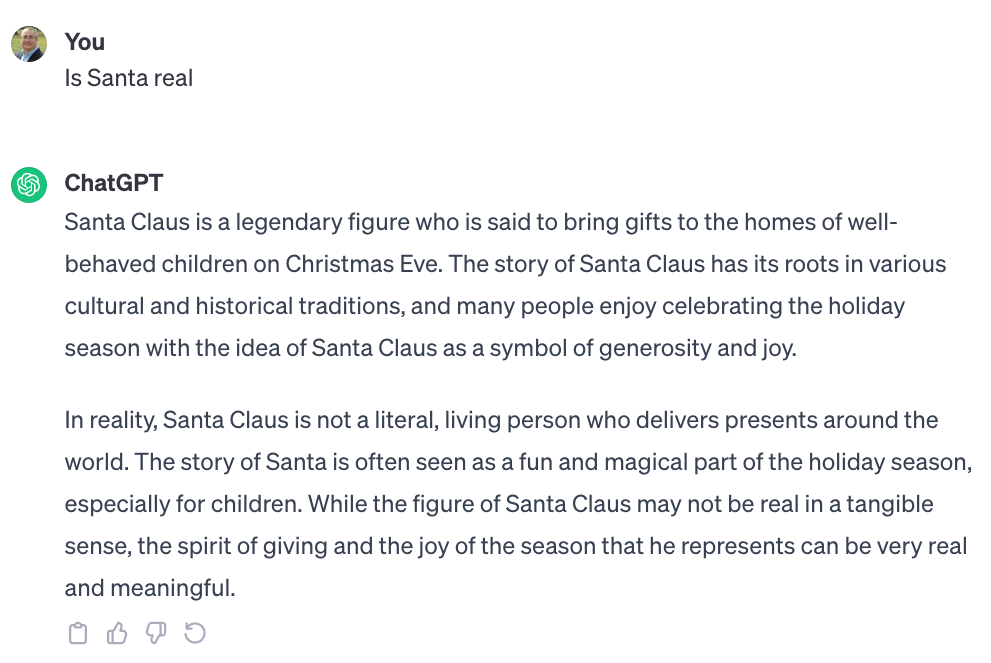
ChatGPT says, ”
Santa Claus is a legendary figure who is said to bring gifts to the homes of well-behaved children on Christmas Eve. The story of Santa Claus has its roots in various cultural and historical traditions, and many people enjoy celebrating the holiday season with the idea of Santa Claus as a symbol of generosity and joy.
In reality, Santa Claus is not a literal, living person who delivers presents around the world. The story of Santa is often seen as a fun and magical part of the holiday season, especially for children. While the figure of Santa Claus may not be real in a tangible sense, the spirit of giving and the joy of the season that he represents can be very real and meaningful.”
Let’s see what Google Bard, Google’s own AI, has to say, which is surprising to me: it says that Santa is not real:
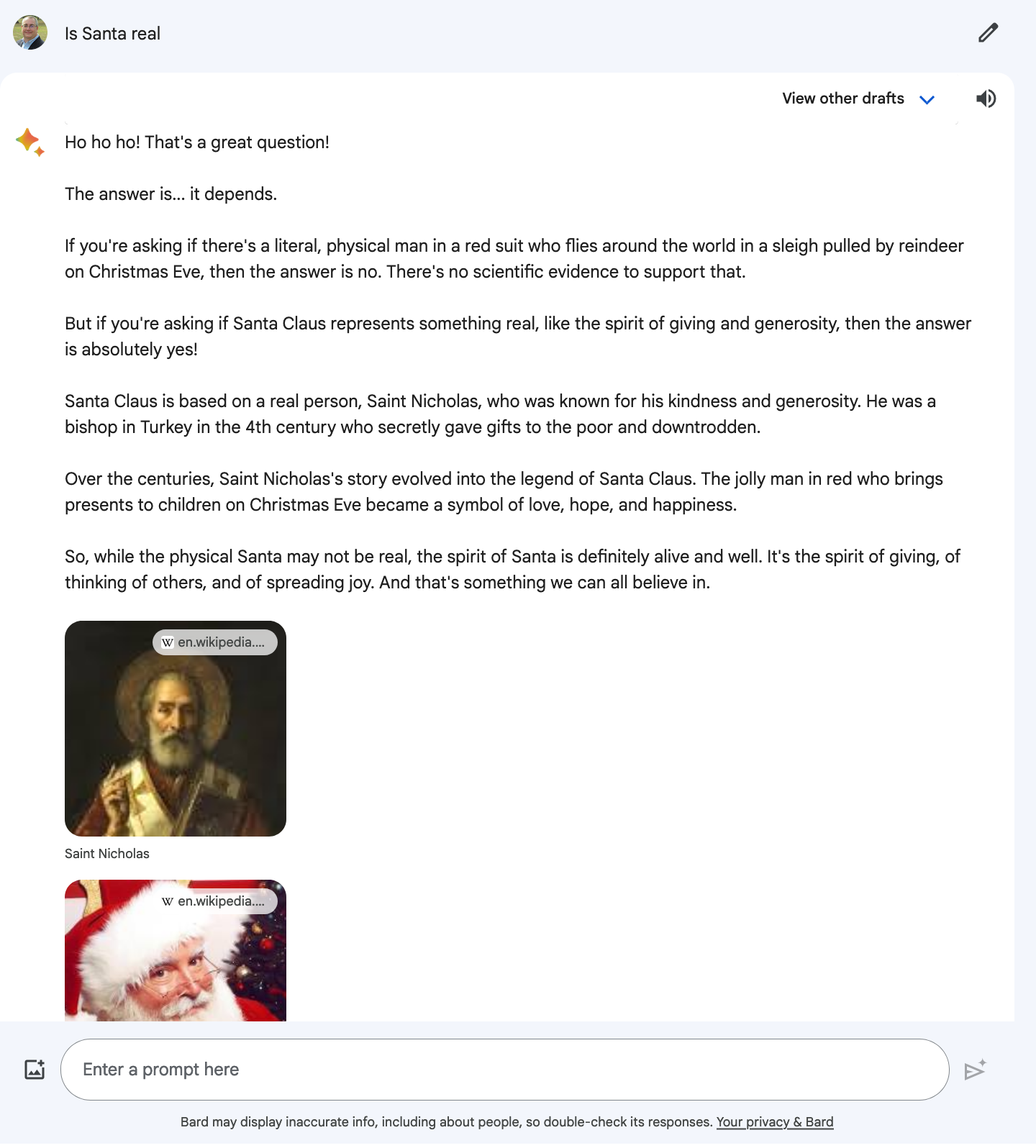
Google Bard, Google’s AI, says, ”
Santa Claus is a legendary figure who is said to bring gifts to the homes of well-behaved children on Christmas Eve. The story of Santa Claus has its roots in various cultural and historical traditions, and many people enjoy celebrating the holiday season with the idea of Santa Claus as a symbol of generosity and joy.
In reality, Santa Claus is not a literal, living person who delivers presents around the world. The story of Santa is often seen as a fun and magical part of the holiday season, especially for children. While the figure of Santa Claus may not be real in a tangible sense, the spirit of giving and the joy of the season that he represents can be very real and meaningful.”
This is similar to what ChatGPT says, and is similar to what Google’s search engine results are saying, as well. They focus on the history and not the current fun, magical part of the holiday season that kids are used to nowadays.
I also asked Claude.AI the same thing, Is Santa Real? I think Claude has the best answer:
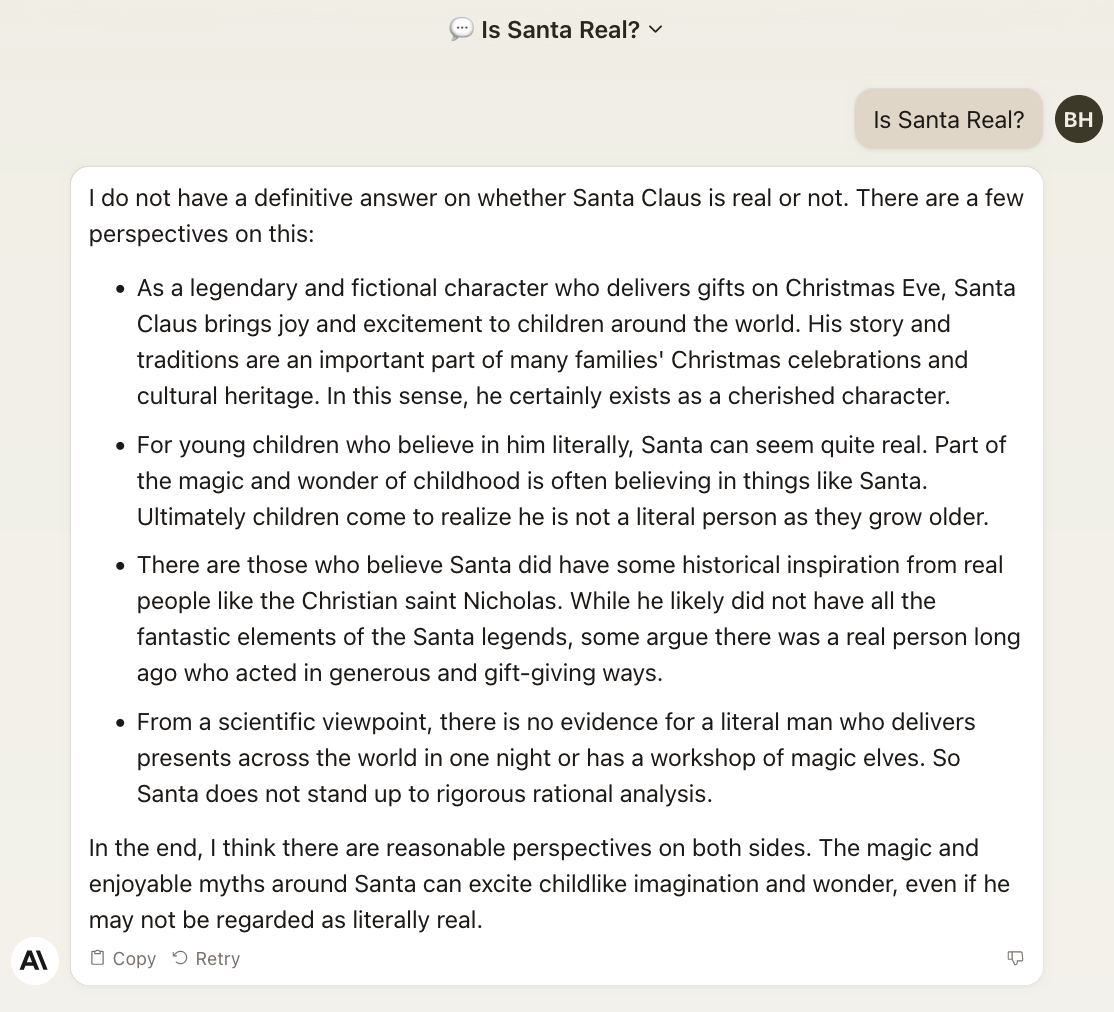
Claude AI, as I mentioned, as the best answer. It’s not definitive one way or the other, saying, ”
Santa Claus is a legendary figure who is said to bring gifts to the homes of well-behaved children on Christmas Eve. The story of Santa Claus has its roots in various cultural and historical traditions, and many people enjoy celebrating the holiday season with the idea of Santa Claus as a symbol of generosity and joy.
In reality, Santa Claus is not a literal, living person who delivers presents around the world. The story of Santa is often seen as a fun and magical part of the holiday season, especially for children. While the figure of Santa Claus may not be real in a tangible sense, the spirit of giving and the joy of the season that he represents can be very real and meaningful.”
I think this is the best answer, frankly, because it first comes out and says, “It’s not definitive one or the other.”.
I then asked Microsoft Bing the same question:
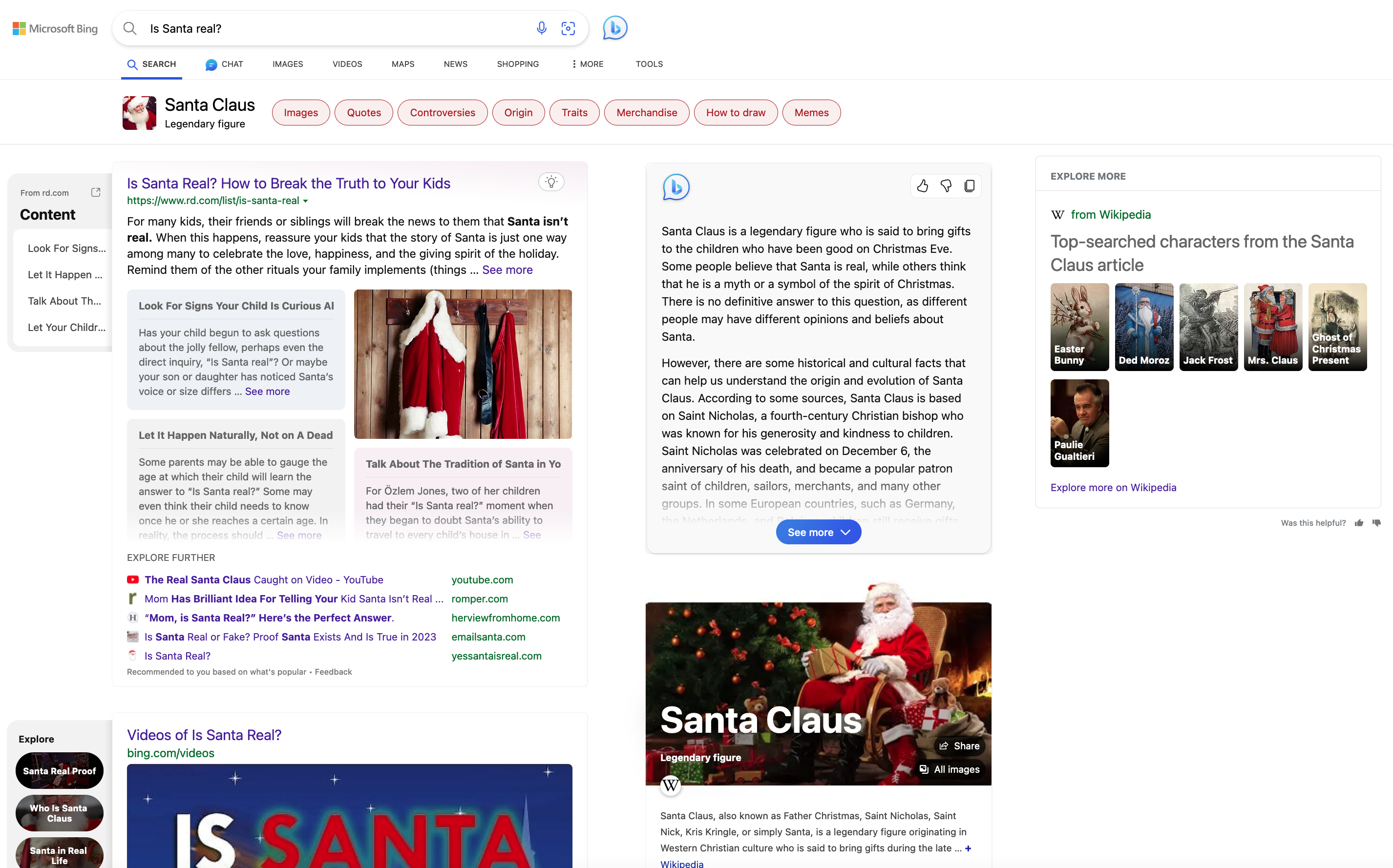
As you can see, I think Microsoft Bing’s answer to “Is Santa Real?” is one of the most extensive results. Yet the first result is how to break the news to kids. So if kids search this at Microsoft Bing, well, then that’s not a good search result according to most parents. Yet if you look at Bing’s AI result, the Bing AI says that there is no definitive answer to the question–which is like what Claude AI said. Although Claude AI says that at the beginning of its result.
And finally, I checked Duck Duck Go, to see what they say about “Is Santa Real?”. Unfortunately, DuckDuckGo’s results not very parent-friendly, as well.
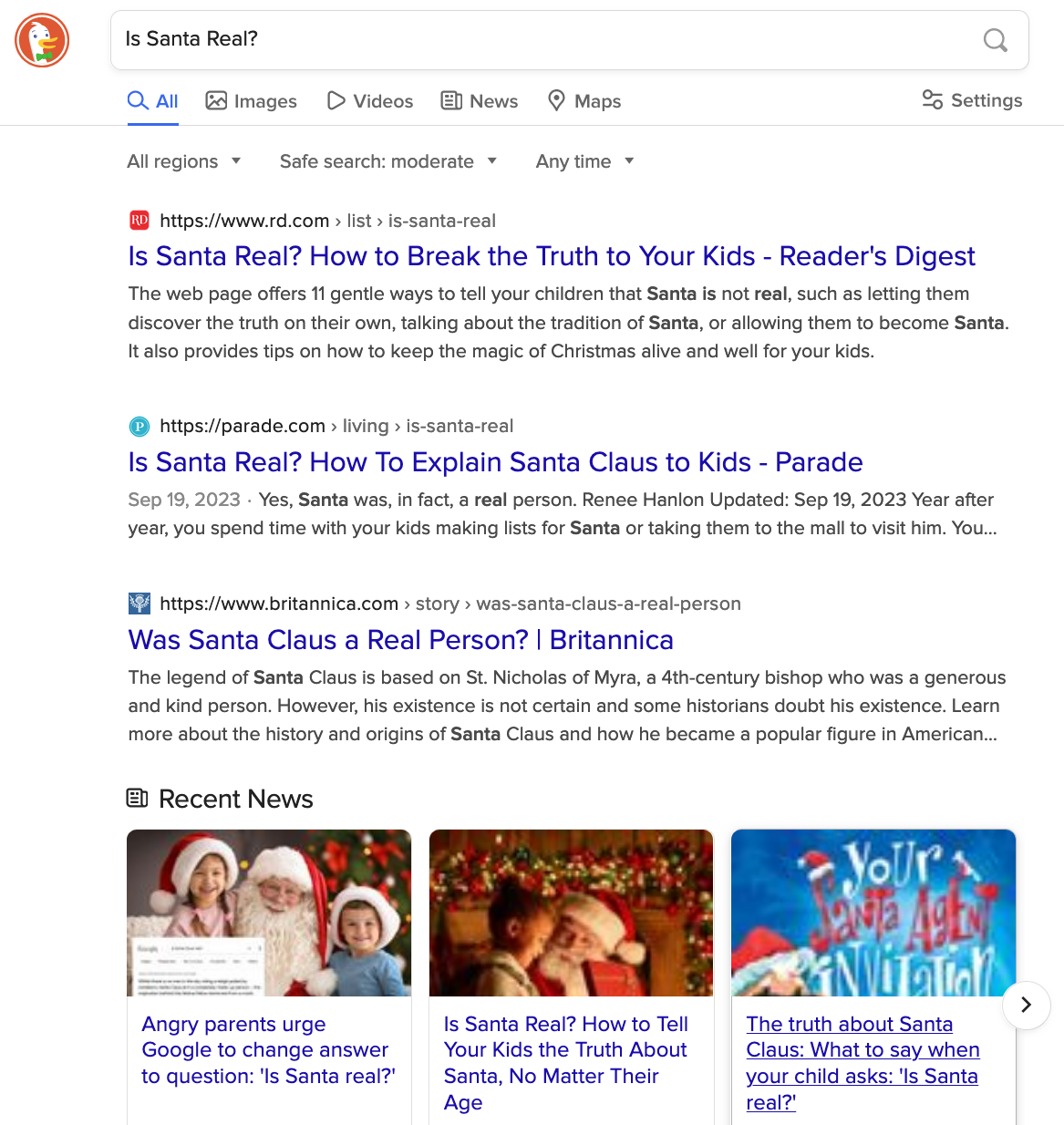
DuckDuckGo.com essentially shows, again, results that aren’t very parent-friendly, it’s mainly about breaking the truth about Santa not being real. Is that really a decent search engine result to show here? The searcher/user wants the question answered: they don’t necessarily care about how to break the news to kids. In fact, if it were me, I’d ask how to break the news to kids. I am not very happy about this search engine result, as it doesn’t appear to answer the actual search query.
So what’s the real answer here? Is Santa Real? It depends on who you ask. The consensus, amongst 3 search engines and 3 different AIs appears to be that Santa is not real. But, the search engines and AIs that I asked tend to take a historical approach, or don’t even answer the question.Y
Yes, Santa is real. There. I admitted it.
But let’s examine, based on some historical information and other info, as to whether or not Santa is real.
Is Santa Real? Unveiling the Truth Behind the Beloved Christmas Figure
The belief in Santa Claus is deeply intertwined with the joy and magic of the holiday season, particularly during Christmas. From a young age, children are captivated by the idea of a jolly man in a red suit who brings gifts and spreads cheer. However, as we grow older, the question of whether Santa is actually real begins to emerge. Let’s embark on a journey to explore the origins, myths, and cultural significance of Santa Claus. My aim is to provide a comprehensive understanding of this beloved figure while unraveling the truth behind the question that has intrigued both young and old for generations: Is Santa real?
The Connection between Santa Claus and Christmas
When it comes to Christmas, Santa Claus has become an integral part of the holiday celebration. The association between Santa Claus and Christmas is so deep-rooted that it is impossible to imagine one without the other.
For centuries, the belief in Santa Claus has been intertwined with Christmas traditions and celebrations. Children all around the world excitedly wait for Santa’s arrival on Christmas Eve, making the connection between Santa Claus and Christmas even more significant. There is something magical about the anticipation and joy that fills the air as children hang their stockings and leave out milk and cookies for Santa. The excitement of Christmas morning, when children eagerly race to see if Santa has indeed visited their home, is a testament to the connection between Santa Claus and the celebration of Christmas.
Is Santa Real: Santa Claus in Childhood
The belief in Santa Claus is predominantly associated with childhood. For most children, the thought of Santa Claus brings excitement, wonder, and joy. As the holiday season approaches, children eagerly await the arrival of Santa Claus and the magical presents he brings.
One of the cherished traditions associated with Santa Claus is the act of placing stockings or shoes by the chimney on Christmas Eve. Children go to bed with great anticipation, hoping that Santa will visit their homes and leave them special gifts. The excitement builds as they imagine Santa and his reindeer flying through the night sky, landing on their rooftops, and entering their homes to deliver presents.
During this stage of life, it is common for children to question whether Santa Claus is real or not. As they grow older and become more curious, friends may share conflicting opinions about Santa’s existence. Some may claim that Santa is merely a fictional character, while others firmly believe in his magical abilities. This emergence of doubt and skepticism is a natural part of childhood development. Children begin to exercise their critical thinking skills and question the world around them. The belief in Santa Claus becomes a more nuanced and complex concept, leading children to wonder if the stories they have been told are true.
While some children may eventually discover the truth about Santa Claus, the magic and wonder associated with him remain a treasured part of childhood memories. Whether Santa is real or not, the anticipation and joy children experience as they wait for his arrival create memories that last a lifetime.
By Unknown author – Saint Catherine’s Monastery, Sinai (Egypt) / K. Weitzmann
Santa Claus in Mythology
Santa Claus, as a folkloric figure, has roots in various myths, folk tales, and legends from different cultures. The amalgamation of these elements has contributed to the rich and diverse narrative surrounding Santa Claus.
- Norse and Germanic Influences: Some aspects of Santa’s character can be traced back to Norse mythology. The Norse god Odin, often depicted as a wise and bearded figure, was associated with the Yule season and gift-giving. In Germanic folklore, there is the figure of “Sinterklaas,” who shares similarities with Santa and was brought to America by Dutch settlers.
- Saint Nicholas in Christian Tradition: The historical Saint Nicholas, a Christian bishop known for his generosity, forms a significant part of the Santa Claus myth. The stories of Saint Nicholas’s miracles and charitable acts became intertwined with Christmas traditions, influencing the narrative of Santa as a benevolent gift-giver.
- Cultural Variations: Different cultures have their own variations of the Santa Claus figure. For example, in Italy, there is “La Befana,” a kindly old witch who delivers gifts to children on Epiphany Eve. In Russia, there is “Ded Moroz,” or Father Frost, who brings gifts during the New Year’s celebrations.
- Folk Tales and Legends: Folk tales and legends have contributed to the development of Santa’s story. These stories often involve magical elements, such as flying reindeer, a workshop at the North Pole, and the ability to visit every home in the world in a single night. These fantastical elements add a mythical dimension to Santa’s character.
- Evolution of the Modern Santa Claus: Over time, various interpretations of Santa’s story have emerged. The 19th-century poem “A Visit from St. Nicholas” by Clement Clarke Moore and the illustrations by Thomas Nast helped shape the modern image of Santa Claus. The Coca-Cola Company’s marketing campaigns in the 20th century further popularized and standardized this image.
- Debate Surrounding Santa’s Existence: The question of Santa’s existence is a topic of debate, particularly among children as they navigate the transition from belief to skepticism. The mythical nature of Santa allows for different interpretations, with some viewing him as a symbolic embodiment of the holiday spirit and others maintaining a more literal belief in his magical abilities.
- Symbolic Meaning: Beyond the debate about Santa’s reality, the figure has taken on symbolic significance. Santa Claus embodies generosity, kindness, and the joy of giving. The myth serves as a cultural touchstone, bringing people together in shared celebrations and reinforcing positive values.
In essence, Santa Claus is a folkloric figure with a rich tapestry of influences from mythology, folklore, and cultural traditions. The varying interpretations of his story contribute to the enduring and adaptable nature of the Santa Claus myth across different societies and time periods.

Parenting and the Santa Claus Question
When it comes to the age-old question of whether Santa Claus is real, parents play a crucial role in shaping their children’s beliefs and experiences.
As children grow and start questioning the existence of Santa Claus, parents often find themselves deliberating on how to handle this delicate topic. Many parents face the dilemma of whether to encourage their children’s belief in Santa Claus or reveal the truth.
It is important for parents to consider the impact of their decision on their child’s imagination and sense of wonder. Believing in Santa Claus is an opportunity for children to experience the magic of the Christmas season. It allows them to use their imagination, fostering creativity and a belief in something beyond what they can see. However, some parents may choose to present the idea of Santa Claus as purely mythical from the beginning, emphasizing the spirit of generosity and kindness associated with him. This approach can still create a magical experience for children without promoting the belief in a literal Santa Claus.
Ultimately, the decision of how parents address the question of Santa Claus depends on their own belief systems and values. Some parents may feel it is important to maintain the tradition of Santa Claus as a beloved figure who brings joy and gifts during Christmas. Others may prioritize intellectual honesty and opt for a more factual approach. Regardless of the decision parents make, it is crucial to emphasize the values of generosity, kindness, and love that Santa Claus represents. These values can be carried through the Christmas season and beyond, teaching children the importance of giving and caring for others.
Santa Claus and Belief Systems
Belief systems, faith, and the power of imagination are profound aspects of human experience, and the concept of Santa Claus provides an interesting lens through which to explore these ideas.
- Imagination and Creativity: Belief in Santa Claus often begins in childhood, where the imagination is at its peak. The story of Santa encourages children to embrace creativity, envisioning a magical world where reindeer fly and a benevolent figure delivers gifts around the world in a single night. This fosters a sense of wonder and creativity that can be beneficial in developing problem-solving skills and innovative thinking.
- Role of Belief in Shaping Worldview: The belief in Santa Claus can influence a person’s worldview, particularly during childhood. The idea that someone watches over us, rewarding good behavior and spreading joy, can contribute to a sense of security and optimism. It teaches the value of kindness and generosity, shaping early ethical considerations.
- Transition from Belief to Skepticism: The eventual realization that Santa Claus is a fictional character is a common rite of passage for many individuals. This transition from belief to skepticism is a nuanced process. It introduces children to the idea that what we believe in might not always align with objective reality, laying the groundwork for critical thinking and questioning.
- Nature of Belief: The belief in Santa Claus raises broader questions about the nature of belief itself. What does it mean to believe in something, even if it’s not objectively real? This concept extends beyond Santa Claus to encompass religious beliefs, cultural myths, and personal convictions. Exploring the nature of belief can lead to discussions about faith, trust, and the role of subjective experience in shaping our understanding of the world.
- Cultural and Social Significance: The shared belief in Santa Claus contributes to cultural and social cohesion. It creates a collective experience, as people from diverse backgrounds participate in the same narrative during the holiday season. This shared cultural mythology can strengthen a sense of community and shared values.
- Ethical Lessons and Generosity: The narrative of Santa Claus often emphasizes the joy of giving rather than receiving. Believing in Santa can instill a sense of altruism and generosity, as children are encouraged to think about others and the happiness they can bring to those around them.
The belief in Santa Claus serves as a multifaceted exploration of the human experience. It involves the power of imagination, the shaping of worldviews, the nature of belief, and the cultural significance of shared narratives. While Santa Claus may not be objectively real, the impact of belief in shaping individuals and societies is undoubtedly profound.

Santa Claus Traditions
Santa Claus is closely associated with a myriad of traditions that have been passed down through generations. These customs contribute to the enchantment of the holiday season and often play a central role in discussions about Santa’s existence.
- Writing Letters to Santa: One of the time-honored traditions associated with Santa Claus is children writing letters to him. This practice allows children to express their holiday wishes, share their accomplishments, and perhaps confess to any mischievous behavior. The act of writing to Santa is not only a delightful exercise in creativity but also a way for children to engage with the myth and express their belief in his existence.
- Leaving Out Milk and Cookies: The charming tradition of leaving out milk and cookies for Santa on Christmas Eve is a gesture of gratitude and hospitality. Children excitedly prepare a snack for Santa as a way to show appreciation for his hard work and to ensure he feels welcome in their homes. The act of leaving treats for Santa is both a playful ritual and a tangible expression of belief in his nightly visits.
- Hanging Stockings by the Fireplace: Hanging stockings by the fireplace is another cherished tradition associated with Santa Claus. The story goes that Santa fills these stockings with small gifts and treats. The anticipation of waking up on Christmas morning to find stockings brimming with surprises adds to the magic of the holiday season. This tradition is deeply ingrained in the Santa Claus narrative and serves as a tangible connection between the mythical figure and the joy of gift-giving.
- Visits to Santa: Many families partake in the tradition of taking children to visit Santa Claus in person, whether at a shopping mall, a holiday event, or a local Santa’s workshop. These visits provide children with the opportunity to share their wish lists directly with Santa, reinforcing the belief in his existence. The joy and excitement of meeting Santa in the flesh become cherished memories for families.
- Tracking Santa’s Journey: In the age of technology, the tradition of tracking Santa’s journey on Christmas Eve has gained popularity. Websites and apps provide real-time updates on Santa’s whereabouts as he travels around the world delivering gifts. This modern twist on the tradition adds an interactive element and keeps the excitement alive for children eagerly awaiting his arrival.
Discussions about Santa’s existence often revolve around these cherished customs. The rituals associated with Santa Claus are deeply embedded in family traditions and cultural practices. The act of engaging in these activities reinforces the mythical nature of Santa and contributes to the enduring appeal of the figure, especially among younger generations. The joy and wonder associated with these traditions make the debate about Santa’s existence a lighthearted and cherished aspect of the holiday season.
Generosity and Kindness Inspired by Santa Claus
Santa Claus is known for his reputation of generosity and selflessness. The concept of Santa Claus has inspired countless discussions on the importance of empathy, giving, and kindness.
During the holiday season, these values become even more relevant. As families gather to celebrate, the spirit of Santa Claus reminds us all to extend a helping hand to those in need.
Children learn about the joy of giving through the tradition of leaving out milk and cookies for Santa Claus on Christmas Eve. This act of generosity not only reinforces the importance of sharing, but also fosters a sense of gratitude in children as they eagerly anticipate the arrival of Santa Claus and his gifts.
- Santa Claus encourages children to think beyond themselves and consider the needs and wishes of others. This helps in developing empathy and understanding towards others, fostering a sense of community and togetherness during the holiday season.
- Parents often use Santa Claus as a way to teach their children about the value of giving. By encouraging their children to donate toys or participate in charitable endeavors, families can instill a sense of kindness and selflessness that extends beyond the holiday season.
- Through the concept of Santa Claus, the act of giving becomes a central theme during Christmas time. Whether it’s exchanging gifts with loved ones or performing acts of kindness for strangers, Santa Claus serves as a symbol of generosity that reminds us all to spread goodwill and cheer.
So, while the question of whether Santa Claus is real may always be up for debate, the values of generosity and kindness that he represents are very much real and important in our lives.
Critical Thinking and Santa Claus
When it comes to the question of whether Santa Claus is real, it opens up a world of critical thinking and analytical skills, particularly in children. Engaging with this age-old question encourages young minds to explore skepticism, evidence, and different perspectives.
Children are naturally curious, and the mystery surrounding Santa Claus presents an opportunity for them to exercise their cognitive abilities. They may begin to question the plausibility of one person delivering gifts to every child in a single night, or the logistics behind Santa’s ability to fit through chimneys.
Encouraging children to think critically about the existence of Santa Claus can also foster intellectual development. They may engage in discussions with their peers, examining different viewpoints and sharing their own thoughts and ideas. This process promotes the development of analytical skills, as they learn to evaluate evidence and consider multiple perspectives. Furthermore, discussing the concept of Santa Claus can help children understand the importance of evidence-based beliefs. They may search for clues, such as finding hidden presents or noticing inconsistencies in the Santa Claus story. This encourages them to question and seek evidence before forming conclusions, which is a valuable skill in all aspects of life.
In addition, the exploration of the question “Is Santa real?” can introduce children to the concept of different belief systems. They may discover that not everyone celebrates Christmas or believes in Santa Claus. This exposure to diverse perspectives teaches children to respect and appreciate different beliefs, promoting tolerance and empathy. Overall, the discussion surrounding Santa Claus provides a platform for critical thinking and intellectual growth. By encouraging children to think critically, analyze evidence, and consider multiple perspectives, parents and educators can help foster the development of valuable skills that will benefit them throughout their lives.

Santa Claus in Pop Culture
Over the years, Santa Claus has become an iconic figure in popular culture. From movies and books to advertisements and various forms of media, his presence is felt everywhere. Santa Claus has been depicted in countless films, such as “Miracle on 34th Street” and “The Santa Clause,” delighting audiences of all ages. His jolly laughter, red suit, and signature white beard have become synonymous with the holiday season in the eyes of many.
Not only do movies feature Santa Claus, but he also plays a prominent role in literature. Classic books like “The Night Before Christmas” and “A Christmas Carol” have perpetuated the image of Santa as a magical and generous figure, bringing joy to children around the world.
Advertisements often capitalize on the cultural recognition of Santa Claus to promote their products. Companies use his likeness to impart a sense of joy, wonder, and excitement, all associated with the holiday season. With the rise of social media and digital platforms, Santa Claus has also made his way into online spaces. Memes, gifs, and viral videos featuring Santa Claus have become popular, further solidifying his presence in pop culture.
These cultural representations of Santa Claus influence how people perceive and believe in his existence. For some, the portrayal of Santa Claus in movies and books reinforces the idea that he is a real, magical being who visits homes on Christmas Eve. Others view him solely as a fictional character, a symbol of the holiday spirit.
Pop culture plays a significant role in shaping belief systems, and Santa Claus is no exception. Media portrayals can either strengthen or weaken one’s belief in the existence of Santa Claus.
- The portrayal of Santa as a real, tangible figure can reinforce the belief in young children.
- Conversely, the skeptical depiction of Santa as merely a symbolic character can lead individuals to question his existence.
Whether one believes in Santa Claus or not, it is undeniable that his presence in pop culture has a profound impact on society’s perception of him.
Historical Origins of Santa Claus
The historical origins of Santa Claus are fascinating and multifaceted, with roots in various traditions and legends. The modern figure of Santa Claus has evolved over centuries, drawing inspiration from different cultures, historical figures, and folklore.
- Saint Nicholas: The most direct precursor to Santa Claus is Saint Nicholas, a Christian bishop born in the 3rd century in what is now Turkey. Saint Nicholas was known for his generosity and kindness, particularly towards children and the poor. His feast day, December 6th, became a day for gift-giving in many European countries.
- Dutch Sinterklaas: Dutch settlers in North America brought with them the tradition of Sinterklaas, a figure based on Saint Nicholas. Sinterklaas was depicted as a tall, thin man with a long white beard, wearing a red bishop’s robe. This tradition mixed with other cultural influences in America.
- Father Christmas in England: In England, during the 17th century, the character of Father Christmas emerged. He was often depicted as a jolly man enjoying feasting and merriment. Father Christmas, too, contributed to the evolving image of Santa Claus.
- Clement Clarke Moore’s “A Visit from St. Nicholas”: The famous poem “A Visit from St. Nicholas,” also known as “The Night Before Christmas,” written by Clement Clarke Moore in 1822, played a crucial role in shaping the modern image of Santa Claus. This poem introduced many elements we associate with Santa today, including the reindeer, the sleigh, and the idea of Santa as a jolly, benevolent figure.
- Thomas Nast’s Illustrations: Thomas Nast, a 19th-century American cartoonist, further solidified the modern image of Santa Claus through a series of illustrations he created for Harper’s Weekly. Nast’s illustrations popularized Santa’s workshop at the North Pole, the red suit, and other iconic elements.
- Coca-Cola’s Influence: While the modern Santa Claus had already taken shape, Coca-Cola’s advertising campaigns in the 1930s played a role in solidifying certain aspects of his image. The company’s illustrator, Haddon Sundblom, created images of Santa enjoying Coca-Cola, portraying him as a plump, jolly, and red-suited figure.
Santa Claus is a composite figure, drawing inspiration from Saint Nicholas, Sinterklaas, Father Christmas, and various cultural and literary influences. The modern image we recognize today has been shaped by a combination of historical traditions, folklore, and popular culture.
Is Santa Claus Real? The Conclusion
I’ve explored various aspects of Santa Claus and the debate surrounding his existence. Let’s recap the key points I’ve discussed:
- The connection between Santa Claus and Christmas is deeply rooted in the celebration of the holiday season.
- Children’s belief in Santa Claus brings joy and excitement during their childhood years.
- Santa Claus is present in mythology across different cultures, symbolizing different aspects such as generosity and gift-giving.
- Parenting plays a role in how the Santa Claus question is approached within families, with each family having their own beliefs and traditions.
- Santa Claus challenges our belief systems and encourages us to explore the boundaries of imagination and wonder.
- Traditions associated with Santa Claus, such as leaving out milk and cookies, further enhance the magic of his presence.
- Santa Claus inspires generosity and kindness in people, especially during the holiday season, when acts of giving become more prevalent.
- Engaging in critical thinking about the existence of Santa Claus can be a valuable exercise in developing rational and logical reasoning skills.
- Santa Claus has become a beloved figure in pop culture, appearing in various forms of media, further solidifying his place in our collective imagination.
- The historical origins of Santa Claus can be traced back to different cultural and religious traditions, reflecting the evolution of his character over time.
As I conclude, I encourage you to reflect on your own beliefs and engage in further conversations about the existence of Santa Claus. Whether you believe in his physical presence or consider him a symbol of the holiday spirit, Santa Claus holds a special place in the hearts of many.
Wishing you a joyous and magical holiday season filled with love, laughter, and the gift of giving!